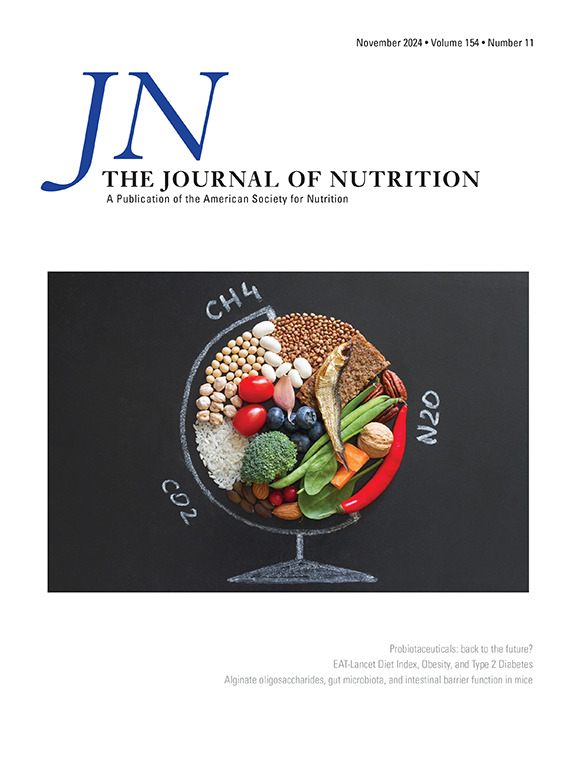人类粪便和血浆中短链脂肪酸的饮食、微生物组和炎症预测因子。
IF 3.7
3区 医学
Q2 NUTRITION & DIETETICS
引用次数: 0
摘要
背景:肠道微生物产生的短链脂肪酸(SCFAs)与广泛的健康益处相关。然而,目前还不完全清楚如何调节饮食和/或肠道微生物组来改善 SCFA 的产生:目的:确定健康成年人队列中 SCFAs 的膳食、炎症和/或微生物组预测因素:方法:在美国农业部营养表型研究(USDA Nutritional Phenotyping Study)中对 359 名健康成年人的粪便和血浆样本进行 SCFAs 测量。使用食物频率问卷和 ASA24 膳食回忆对习惯饮食和近期饮食进行了评估。在粪便和血浆样本中测量了全身和肠道炎症的标志物。肠道微生物组采用枪式元基因组学进行评估。通过统计和机器学习,我们确定了 SCFAs 的丰度和组成如何随饮食、炎症和肠道微生物组的变化而变化:结果:我们发现粪便 pH 值可以很好地代表粪便中 SCFA 的丰度。相对于乙酸盐和丙酸盐,较高的健康饮食指数与粪便中丁酸盐成分的增加有关。SCFA与亚临床消化道炎症的标志物有关。粪便中的 SCFA 丰度与血浆脂多糖结合蛋白成反比。当我们使用分类感知算法对分层组织的饮食和微生物组数据进行分析时,我们发现饮食和微生物组特征对粪便SCFA丰度的预测性远远高于血浆SCFA丰度。膳食和微生物组对粪便丁酸盐的最大预测因素分别包括马铃薯和硫胺素生物合成途径:这些结果表明,马铃薯中的抗性淀粉和微生物产生的硫胺素分别为丁酸盐的合成提供了底物和必要的辅助因子。硫胺素可能是成人丁酸盐生成的限速营养素。总之,这些发现说明了肠道中产生 SCFA 的复杂生物学基础。该试验已在 clinicaltrials.gov 登记为 NCT02367287。本文章由计算机程序翻译,如有差异,请以英文原文为准。
Diet, Microbiome, and Inflammation Predictors of Fecal and Plasma Short-Chain Fatty Acids in Humans
Background
Gut microbes produce short-chain fatty acids (SCFAs), which are associated with broad health benefits. However, it is not fully known how diet and/or the gut microbiome could be modulated to improve SCFA production.
Objectives
The objective of this study was to identify dietary, inflammatory, and/or microbiome predictors of SCFAs in a cohort of healthy adults.
Methods
SCFAs were measured in fecal and plasma samples from 359 healthy adults in the United States Department of Agriculture Nutritional Phenotyping Study. Habitual and recent diet was assessed using a Food Frequency Questionnaire and Automated Self-Administered 24-h Dietary Assesment Tool dietary recalls. Markers of systemic and gut inflammation were measured in fecal and plasma samples. The gut microbiome was assessed using shotgun metagenomics. Using statistics and machine learning, we determined how the abundance and composition of SCFAs varied with measures of diet, inflammation, and the gut microbiome.
Results
We show that fecal pH may be a good proxy for fecal SCFA abundance. A higher Healthy Eating Index for a habitual diet was associated with a compositional increase in fecal butyrate relative to acetate and propionate. SCFAs were associated with markers of subclinical gastrointestinal (GI) inflammation. Fecal SCFA abundance was inversely related to plasma lipopolysaccharide-binding protein. When we analyzed hierarchically organized diet and microbiome data with taxonomy-aware algorithms, we observed that diet and microbiome features were far more predictive of fecal SCFA abundances compared to plasma SCFA abundances. The top diet and microbiome predictors of fecal butyrate included potatoes and the thiamine biosynthesis pathway, respectively.
Conclusions
These results suggest that resistant starch in the form of potatoes and microbially produced thiamine provide a substrate and essential cofactor, respectively, for butyrate synthesis. Thiamine may be a rate-limiting nutrient for butyrate production in adults. Overall, these findings illustrate the complex biology underpinning SCFA production in the gut.
This trial was registered at clinicaltrials.gov as NCT02367287.
求助全文
通过发布文献求助,成功后即可免费获取论文全文。
去求助
来源期刊

Journal of Nutrition
医学-营养学
CiteScore
7.60
自引率
4.80%
发文量
260
审稿时长
39 days
期刊介绍:
The Journal of Nutrition (JN/J Nutr) publishes peer-reviewed original research papers covering all aspects of experimental nutrition in humans and other animal species; special articles such as reviews and biographies of prominent nutrition scientists; and issues, opinions, and commentaries on controversial issues in nutrition. Supplements are frequently published to provide extended discussion of topics of special interest.
 求助内容:
求助内容: 应助结果提醒方式:
应助结果提醒方式:


